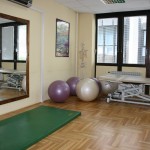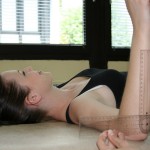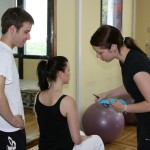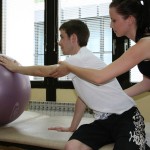Study curriculum | Accreditation [PDF]
INTRODUCTION
Rationale
In order to contribute to the understanding of physical therapy as distinct profession, the World Confederation of Physical Therapy defines physical therapy as an “independent health profession that provides the services of development, maintaining and restoring of maximum mobility and functional capacity and comprises providing support in circumstances where motion and function are affected by the process of aging, injury or disease”.
Today physical therapy is used in practically all clinical fields. Hence a physical therapist is a regular member of professional medical teams in orthopaedics, rheumatology, neurology, cardiology, pulmonology, paediatrics, surgery and traumatology, oncology, gynaecology, obstetrics and sports medicine. Physical therapy is among the leading activities in special rehabilitation hospitals and rehabilitation centres. The role of physical therapist is also recognised in institutions of social care, homes for the elderly, health tourism, and sports teams.
Physical therapist is a health professional who plans and implements therapeutic and rehabilitation procedures by applying the knowledge and skills of physical therapy, clinical kinesiology, basic biomedical sciences, clinical medicine and other allied fields. As part of her/his activities a physical therapist carries out assessment, therapeutic intervention and evaluation of therapeutic effects. A physical therapist participates in the procedures of primary and secondary prevention.
A physical therapist should also possess knowledge and skills that enable successful communication with the patient, the patient’s family, and other professional team members; knowledge and skills are needed to be able to give information and to assist in the promotion of independence of patient and the ability to adequately care for her/himself after dismissal from health institution. It is also important to have knowledge and skills in keeping records about all forms of intervention, application parameters and direct results of each single intervention in terms of functional status: e.g. muscle strength, endurance, quality and range of motion in the joint.
As reported by the Croatian Physical Therapists Association there are 1153 currently employed physical therapists in Croatia who have completed higher education, i.e. a two or three-year study program in physical therapy. When compared with the number of population in Croatia, there are 3093 people per one physical therapist. In some European countries the ratio is significantly lower, for example, in Slovenia there 1404 people per one physical therapist, and 1350 in Austria.
Demographic trends showing gradual increase in the number of elderly people and modern way of living, characterised by mechanisation, automation of labour processes, and computerisation, leading to increasingly lower physical load at place of work, accompanied by sedentary way of living, have contributed to significant increase in the incidence of chronic non-infectious diseases. Based on the data of Croatian Institute of Public Health, published in Croatian Annual Health Statistics Bulletin for 2004, at the level of diagnoses reported by general practitioners (primary health care services), the diseases of the respiratory system rank first among the most commonly reported conditions (25.0%), followed by cardiovascular diseases (12%), and diseases of the musculoskeletal system (10.3%).
Current Experiences with Similar Programs
The formally organised education of physical therapists started in Zagreb in 1948. Today their education is carried out in Zagreb University of Applied Health Studies, Rijeka University School of Medicine, Split University School of Medicine – Department of Health studies and Vukovar Polytechnics Lavoslav Ružička.
In its content the education is aimed at coordination between the needs of society and the needs of health care system, by following the development of the profession and current world and European trends in education. In 1999/2000 school year the Croatian National Council of Higher Education has issued accreditation for three-year academic study program in physical therapy. Previously, from 1968 to 1998, in Croatia there existed a regular two-year post-secondary study program for physical therapy.
In view of the new Act on Scientific Activity and Higher Education, issued in 2003, all new study programs need to be “comparable with the study programs of EU countries” (para 2, art. 78 of the Act). Hence the education of physical therapists in Croatia needs harmonisation with European and world training standards, which implies accepting and implementation of professional study program of physical therapy upon completion of which the degree of baccalaureate in physical therapy is achieved. A physical therapist completing pre-graduation study program should be able to continue her/his education at any graduate study program in Croatia or in any other European country where such programs exist. A physical therapist also needs to have the possibility for continuing education, particularly in terms of gaining physiotherapeutic skills and concepts through internationally recognised courses.
Special emphasis is given to the need that physical therapists who are also trained to teach participate in the courses of specific professional areas and clinical practice. Presently there are 50 professional collaborators/teaching assistants with three-year study program in physical therapy who participate in the carrying out of training courses and clinical practice at Zagreb University of Applied Health Studies, Department of Phisiotherapy. It is important that for these physical therapists continuation of training be ensured at graduate and post-graduate levels in order to enhance the degree of knowledge, skills and competences needed in working with students. Furthermore, to achieve the goals of rationality and efficacy of health services it is important to employ physical therapists who possess the knowledge, skills and competences for an efficient organisation and implementation of physiotherapeutic process; physical therapists who possess the knowledge, skills and competences to develop evidence based physiotherapeutic practice.
Having in mind recognisability and compatibility of programs the European ones, the basic idea in structuring the program was to define educational levels, achievements, and competences the physical therapists would achieve upon completion of study program. Hence in defining educational objectives and levels the recommendations of fundamental documents of European Physiotherapy Benchmark Statement, 2004, was referred to. European and world educational standards for physical therapy point out the need of pregraduate and graduate study programs (WCPT Declarations of Principle and Position Statements, 2003; European Region of the World Confederation for Physical Therapy, 2004). The document also propose the so-called “bridge programs” for education of physical therapists at postgraduate or doctorate level.
Bologna Process
ECTS score transfer system contributes to recognisability and comparability of study programs and competences arising from it, contributing thus to mutual recognition of professional qualifications and possibilities of getting proper education in Croatian institutions of higher education and in European ones that offer study programs in biomedical fields.
In designing the programs based on the ECTS score system the reference programs of Bologna Declaration European signatory countries were used. For example, Curriculum Physiotherapy Degree Programme in Aarhus, 2003; Curriculum Framework for Qualifying Programmes in Physiotherapy, CSP, 2002.
The pre-graduate study program in physical therapy is based on strict professional topics of physical therapy, clinical contents, obligatory basic sciences, and additional health contents. The training implies gaining knowledge and skills concerned with the assessment of status, definition of goals and planning and application of physical therapy according to age, needs and dysfunction of the patient. The principle study program objective is to train the students to be able to work independently in health and other institutions in which physical therapy is carried out.
Continuing education provides for further improvement of knowledge and skills needed for the following: independent and fully responsible implementation of specific physiotherapeutic areas based on students’ interest; planning, preparation and implementation of organised forms of teaching aimed at transfer of knowledge and skills in physical therapy; planning preparation and carrying out of research in the field of physical therapy and acquiring knowledge and skills needed to plan, organise, manage and coordinate human and material resources in the field of physical therapy.
The study program is designed in a way to enable further, i.e. continuing education for physical therapists
General information
Teaching Institution
University of Applied Health Sciences
Name of the Study
Professional Study Program in Physiotherapy
Duration
Three (3) academic years (6 semesters)
Admission Conditions
Fully completed four-year secondary school program and entrance exam,evidence of no contraindications for the chosen profession and admission procedure, which is implemented in accordance with the decision of the Expert Council of the University of Applied Health Sciences.
Job Skills and Competences
Competences of Graduate Students
The following are the objectives of professional study program of physical therapy: theoretical and practical courses enabling the graduates for independent work in health institutions; knowledge and skills needed in the assessment of status, definition of goals and elaboration of program according to age, needs and dysfunctions of the individual who needs physical therapy; providing insight into the concepts of physical therapy with emphasis on holistic approach in the implementation of physical therapy; conceptual possibility to e part of team process of health and nursing care and rehabilitation.
The study program should enable the future professional physical therapists in the following:
- humanistic and holistic approach to the individual undergoing physical therapy treatment
- becoming sensitised to individual needs and desires of the clients
- acting according to the defined or observed needs
- acquiring skills
- funding their practice on knowledge
- development of critical thinking
- stimulating interest for continuing professional education.
A professional physical therapist is able to do the following:
- assess the status of clients and the need for physiotherapeutic treatment
- carry out kinesiometric and other measurements for the diagnosis of musculoskeletal and other systems functions
- plan and program physiotherapeutic procedures
- apply the selected physiotherapeutic procedures according to the clients’ needs
- evaluate treatment effects
- participate in team work, continuing professional education, and promotion of the profession.
Job Skills
A professional physical therapist is qualified to do the following: carry out the procedures of patient assessment, apply therapeutic procedures; work in professional team; keep records; carries out patient education; participate in prevention activities.
A professional physical therapist plans, organises and carries out a physiotherapeutic process within the following clinical branches: orthopaedics, neurology, rheumatology, cardiology, pulmonology, gynaecology, obstetrics, surgery, traumatology, paediatrics, geriatrics, sports medicine, oncology.
Clinical duties and activities of a physical therapist are as follows:
- physiotherapeutic assessment
- definition of physiotherapeutic treatment goals, identification of problems
- definition of plan of physiotherapeutic treatment
- therapeutic exercises
- manual therapy techniques
- respiratory therapy
- application of appliances, prostheses, orthoses, adaptive, protective and supportive devices and equipment
- electrotherapy and physical agents
- mechanical therapeutic procedures
- functional training in self-care and care about the household
- education of patients
- coordination and communication with team members
- records keeping
- primary and secondary prevention of injuries, damages, functional limitations and disability.
Communication skills and knowledge about psychological factors help a professional physical therapist in developing positive relationships with the patient and the patient’s family aimed at decreasing anxiety and creating motivation needed in the therapeutic process. Likewise, a professional physical therapist communicates with members of different health, therapeutic, rehabilitation, social and education teams, all of which contributes to the achievement of therapeutic goals.
The activities of a professional physical therapist are based on ethical and professional principles of a health worker in accordance with ethical code of national physical therapists association and defined standards of physiotherapeutic practice. A professional physical therapist respects basic rights and dignity of each individual, abides by the law and rules of physiotherapeutic practice, works honestly, professionally and consistently, providing services the quality of which is based on legally defined norms.
Other information
Venues for study program implementation
- University of Applied Health Sciences, Mlinarska 38, Zagreb,
- Institutes and clinics of the Zagreb School of Medicine,
- Faculty of Kinesiology University of Zagreb,
- Departments in general and specialized hospitals in Zagreb nad its surroundings,
- Rehabilitation centres and centres for home care,
- Health centres,
- Private practice,
- Sport clubs, recreational clubs, associations for the cancer patients, people with paraplegia, people with vision impairmen, etc.)
- Community rehabilitation units,
- Retirement homes,
- Sports swimming pool “UTRINA”, Zagreb
- Sports hall of the secondary school “Vladimira Preloga”, Zagreb
Spatial requirements (lecture halls) and equipment needed for study program implementation
Lecture halls with classical and modern audio-visual equipment, demonstration rooms equipped with multimedia and video equipment, TV system, IT equipment (maximum two students per one computer), library – IT hub. Lecture halls with multimedia consoles,possibility to projec from the computer, CARNET connections, necessary textual, graphic, audio, multimedia, simulation and communication software. Demonstration rooms: anatomy, physiology, nursing care demonstration rooms. Demonstration rooms for practical training with the necessary equipment to carry out measurement procedures and transformation processes in the field of physiotherapy, a pool. Modern departments with all additional equipment for performing diagnostic and therapeutic procedures.
Evaluation of the study program implementation and efficiency
Quality of the teaching process is evaluated by an anonymous questionnaire on the quality of the organization of the teaching process, the study content, the quality of teachers’ work, etc. The student attendance and their participation in lectures is duly observed. The questionnaire evaluates the usefulness of the lectures, clarity of teaching, new content load and other content-related elements. The plan and its implementation is compared as well as the number of students attending the lectures and practical classes.









